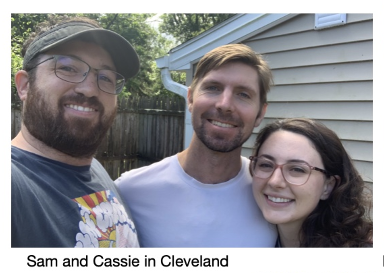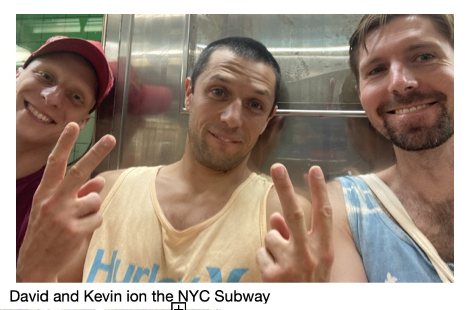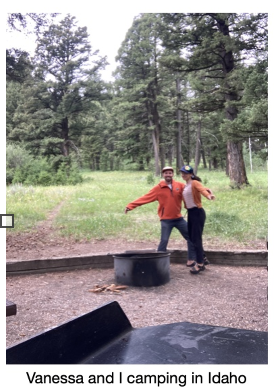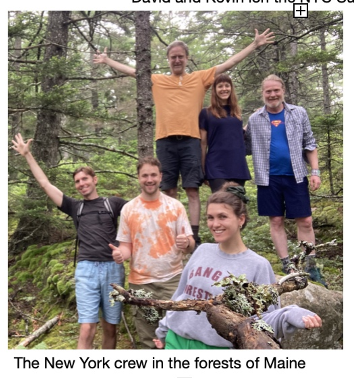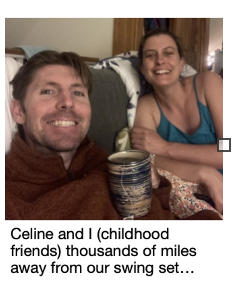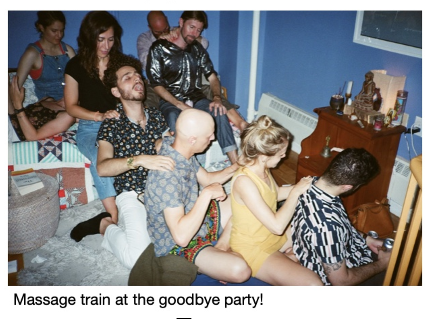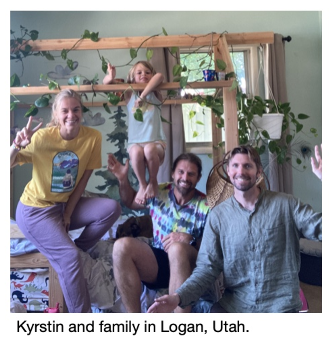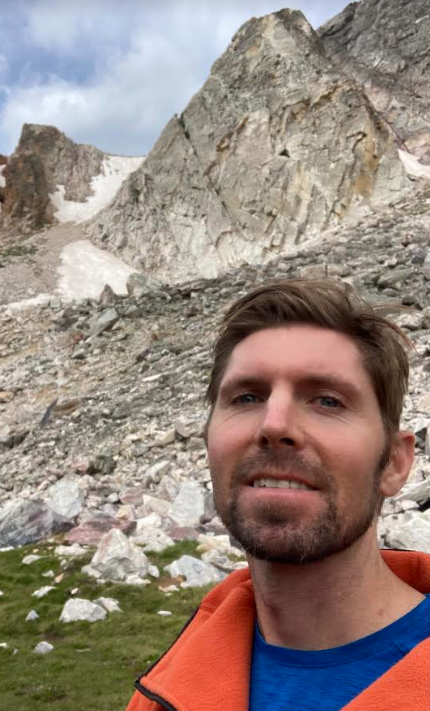After crossing the country from New York City to Portland, Oregon, I landed with dear friends, with a couple of days to spare to get ready for a month-long backpacking trip with Dharma teachers Soten and Shinei. A couple of days quickly passed, and became a couple of hours, becoming mere moments. My dear friend Eric drove me up Mount Hood as I continued to shoot off text messages. It was an hour to drive, and he had a good story to tell, but I was about to be off my phone for a month and I still managed to have some loose ends. I was a bad listener. Sorry, Eric! He was a great driver. Thanks, Eric!
We arrived to our destination, where a number of humans and a dog huddled around food by the roadside. I saw old friends and met new ones, weaving stories within our very first interactions. We were Colin, Mimi, Veronica, Tom (him), Thomas (me), Soten, Shinei, Robin, and Cata. Remembering now our first day on the trail, I think back with such fondness—our naivete, our blister-less feet, the kind and wet landscapes on the west side of Mount Hood. “Leg one” of our three-leg hike would be circumambulating the mountain, seeing her majesty from all sides! We moved through mountain meadows and rocky trails. In one moment, the mountain would sparkle with life in all manner of ways—flowers, butterflies, waterfalls. Then we would walk through a burn, and later on, the rocky side of the mountain, where patches of snow interspersed an otherwise dry landscape.
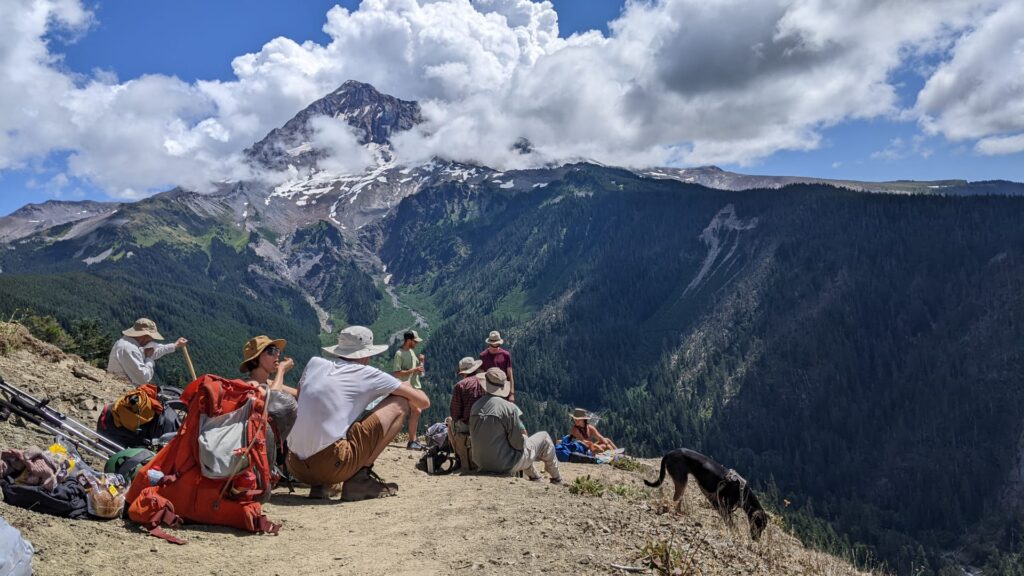
Each day we would wake around 4:30 and started meditation with an awakening energy practice, along with tea and a small piece of chocolate. After our morning meditation, service, and breakfast, we would breakdown camp and got to hiking. By now it would be about 9 AM, and we would hike until lunch—dependent on a mix of timing, distance, and mood. Until lunch, we hiked and practiced in silence. At lunch, we broke silence until dinner. Hiking in community, we moved through different constellations of connection, each pair or group finding their own way of inter-being. As we walked slowly or quickly, gathered water, tied shoes, or took breaks, new constellations of relationship would form, weaving us more thoroughly together. The first leg of the trip we hiked about 40 miles, out of almost 200 during the whole trip. Plenty of time to be with the mind, and to be with friends.
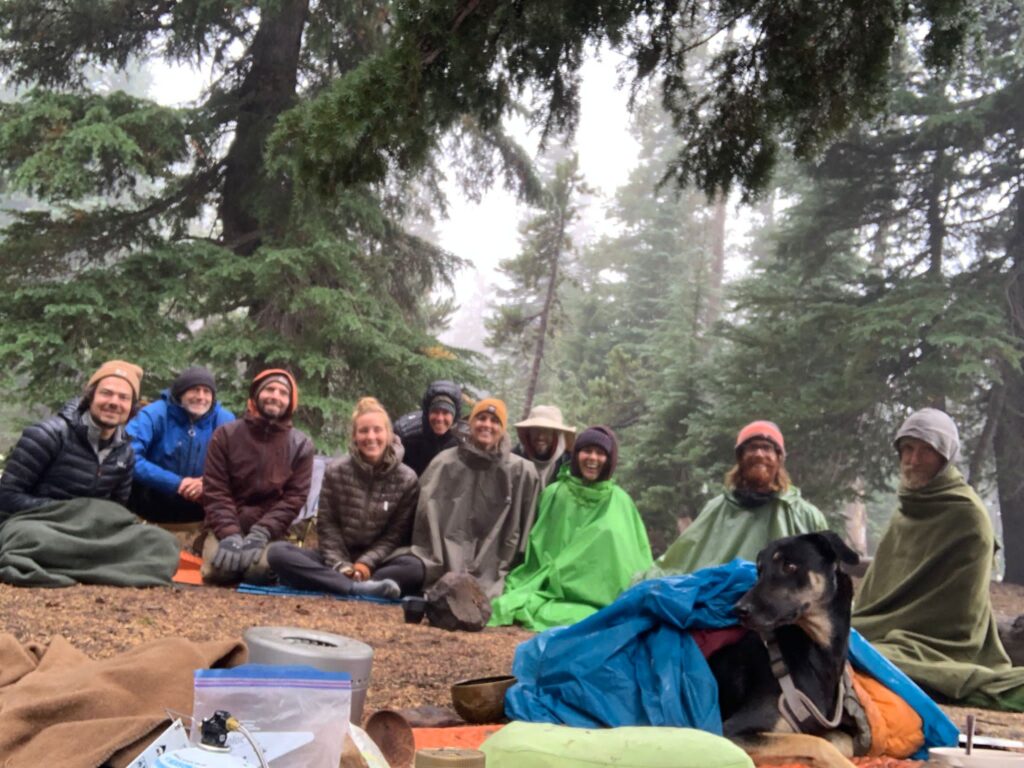
At the end of our Mount Hood segment, we camped above the Timberline Lodge and attempted to make reservations for breakfast in the morning. Things looked gloomy as Soten’s try at a reservation fell short (for lack of charisma, let’s say.) Yet, it was not without hope! Shinei’s shining smile, and her Jedi mind-tricks helped to manifest a breakfast reservation when morning came. We drank coffee, and ate richly. The Timberline Lodge bustled with tourists, hotel guests, and Pacific Crest Trail hikers, a unique assortment of beings living luxuriously, and others encountering their first warm water in days or weeks. I found the Timberline Lodge to be a beautiful setting of comfort and compassion, as so many different kinds of people came together to enjoy the mountain in their own way. They even let us use the bathroom.
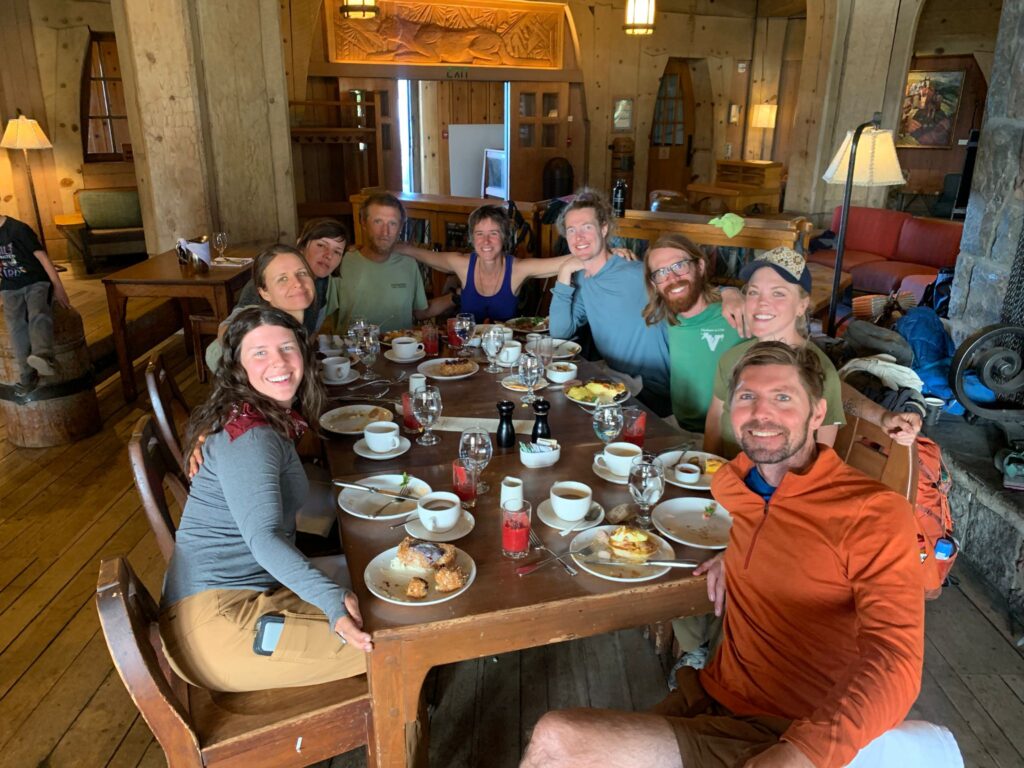
“Leg Two” was the stuff of legends. It took us down Mount Hood, around Mount Jefferson, and then to the Three Sisters area. Did you know you can walk from one mountain to another? Something about that was surprising and deeply empowering. As the days passed by, knees aching and toes blistering and muscles wearying, our schedule slowly shifted. The reality was that we were going slower than expected, and that we needed to be going just that slow. We started sleeping-in one more hour each day, while Soten continued to get up early, honoring the silence before the sunrise.
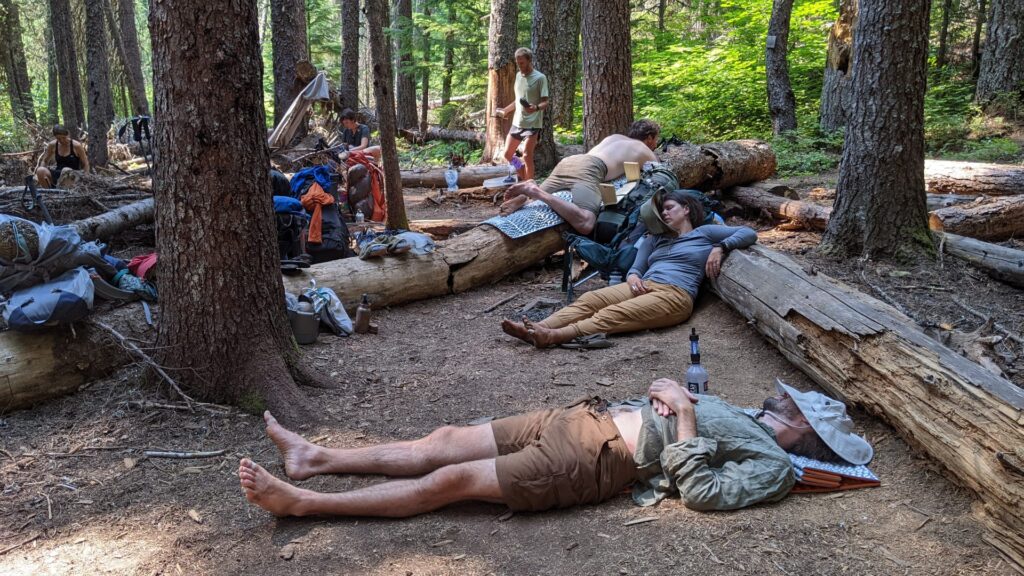
We cannot forget our dear friend Samaya. We don’t know why Samaya was named Samaya, whether she broke samaya in another lifetime and re-incarnated as a dog, or perhaps some good omen, seeing that she, as a puppy, crawled out of the trash and was quickly adopted by Soten and Shinei as they walked by in Central America. Samaya knew we were her pack, so one night when she didn’t come back for a little too long, our collective concern grew. Soten ran one way to check for her, and then back the other way, and finally again in the direction that we would be going the following day. The rest of us stayed back by our water source and stayed the night, wondering about Samaya and Soten and their travels through the night.
The next morning, we started hiking south to follow Soten and, hopefully, Samaya. Pacific Crest Trail hikers are generous in their information sharing, and several had either seen Soten or heard of a dog hiking south. This was another example of the constant exchange of information that exists on the PCT—where is the water, where is good rest, what can I expect. The rest of us continued hiking, hours and miles behind Soten and Samaya, and intermittently received messages with our spotty service, hinting at Samaya’s presence on the trail. As we hiked, the fire of bodhicitta was ignited, and Mimi, the most blistered among us, proposed that we finish the previously planned two-day hike in one day, making it a 17-mile day. The women of the group led while the three of us men just tried to keep up. It was a feat! We were the last to camp, where we were greeted by happy hikers, Samaya, skittles, beer, and the promise of two(ish) days of rest. We had crossed the threshold into being halfway through the trip. The next week was our longest half, and was often threatened by, or affected by, the smoke. At Olallie Lake, our halfway point, we saw smoke rising up over the distant Mount Jefferson.
As we got back on the trail, two hikers decided to step off the trail. One for a few days (our heroic Mimi, to care for her blisters) and another, who left to Great Vow Monastery also to care for her heavily-walked-upon feet. This was one of the more difficult days of hiking, at least emotionally. At lunch, I left the group after singing our lunchtime song to go cry in the stream made by melting glacial waters. The heart doesn’t just open one way, it opens all ways and in every direction. And that’s a lot. Best to let the water take it, the rocks to hold it.
Hiking southward the east side of the cascades, in this section of the hike we encountered miles upon miles of burnt forest. Day by day conditions would change, with varying levels of smoke to walk through, each of us with our sensitivities, reactions, and meanings attached to what the smoke meant for our body, our world. This section of the hike felt like a pre-apocalyptic training ground. What a treat, to meet the end of the world with a roving band of bodhisattvas. Where else would you rather be? Where else could you be?
Did I mention the huckleberries? No. Come to Mount Jefferson in the high summer and nibble to your hearts delight. Do not plan to walk fast, there is much, MUCH snacking to do! But Soten is waiting ahead at our new camp. One more huckleberry. On our night at Mount Jefferson, we made the collective decision to sleep in an extra hour. Only two of us did. The others woke up before the sun to greet the stars and mountain, much to my benefit There’s nothing quite like sleeping within the vicinity of meditating people.

We hiked for another week across the cascades, about 10 miles a day. We crossed the lava fields and Highway 126, the road that I probably most love in the world. Strange to love a road. We wound our way into the Three Sisters Wilderness, and down to the lake where our dear Veronica ended her journey with us, and picked up four fresh new meditators with lots of food. Apples! Cheese! Greens! Finally we were on our last leg. Once a creature becomes three-legged there’s really no counting how many it might grow.
In all reality, this pilgrimage had become a many-legged beast. But one of the many legs was our weeklong retreat by a hidden mountain lake. It sounds idyllic. And it was! Alas, many of us know the idiom: “Wherever you go, there you are.” For a week we sat in a circle, breathing together, and singing together. The simplicity unveiled itself: all we were really doing was sitting, eating, and sleeping. On sesshin, we speak few words, lending our ears, and attention, to the Earth. The sounds of water gushing out of a mountain spring. Of rocks tumbling. The afternoon delight of watching friends swim. It was here I remembered, while swimming across our little mountain lake (a pond, perhaps) — “Oh yeah! I love being alive!” It struck with both grief and joy, as I had forgotten. Life had become a problem. I fear that I’ve done it again—made it a problem—and I pray to remember again: “Oh yes! I love being alive!”
We walked back down the mountain, towards Bend, over a couple of days. By another lake, on a rainy night, we started our first fire of the whole month. The warmth penetrated through the cold night air, and the mountain monks gathered with few words, enamored by light and the play of flames. Wendell Berry writes “To go in the dark with a light is to know the light; to know the dark, go dark.” It’s nice to know the dark. But it’s also nice to know the light and warmth of fire, and of good Dharma friends.
What did we do on our journey? We walked a lot, and I think we got closer. Closer to each other, of course. But also closer to the Earth, and closer to the stars. We got closer to the mountains, and to the huckleberries, and to the mountain goats. Closer to the fire. Close enough to see, to taste, to smell. Closer to our footsteps, and closer to our breath. There’s something else too. I’m not sure quite what it is, but I think we got closer to that too.
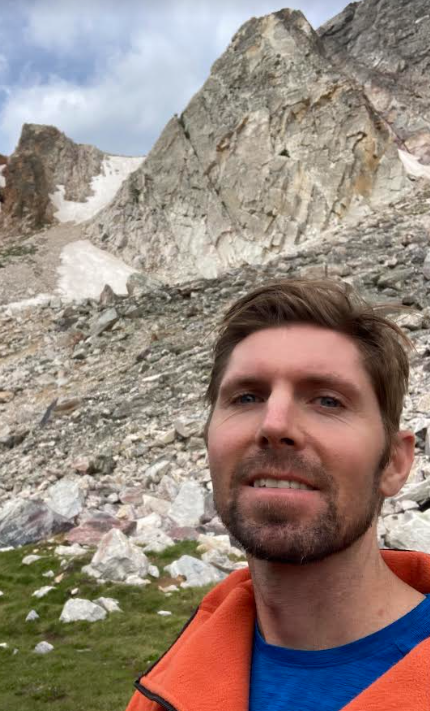
Thomas Walker is a Dekeling community member living in Brooklyn, New York. He has practiced Zen in Oregon at Blue Cliff Zen Center and at Great Vow Zen Monastery, where he met Lama Lekshe in 2018. He recently completed his training as a chaplain at Mount Sinai in New York, and also loves making music with friends.

